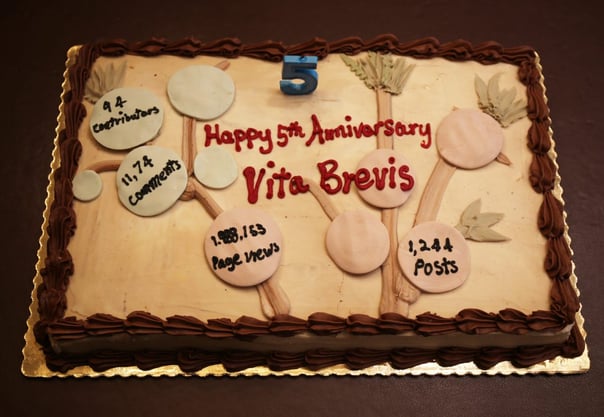 In January 2019, Vita Brevis marked its fifth anniversary with a series of posts, among them one on the blog “By the numbers.” After listing a number of statistics about the blog to that point, I made the following comments:
In January 2019, Vita Brevis marked its fifth anniversary with a series of posts, among them one on the blog “By the numbers.” After listing a number of statistics about the blog to that point, I made the following comments:
[But] Vita Brevis is more than the numbers, the percentages, the ongoing series. It is meant to educate; it is meant to entertain. Like P. L. Travers’ Mary Poppins, it aims to guide its readership – gently, with carrots, not sticks – to the right path, toward genealogical breakthroughs. How? By breaking down the thought processes that successful genealogists use to undertake fresh research, building upon previous work when assessing a new genealogical problem.
Not all the bloggers are professionals, and not all of their stories are successes – as yet! It is as important to demonstrate what not to do as to proffer guarantees of success. So Vita Brevis bloggers sometimes emphasize their research failures as a necessary stage in the process. (As I have occasionally reminded commenters, though, do not mistake a blogger’s modesty for ineptitude!) Indeed, if the blog was an unblemished record of success, with genealogists unerringly pulling up the record and finishing off the journal article, it would be far less interesting to read, for the aspirant as well as for the professional.
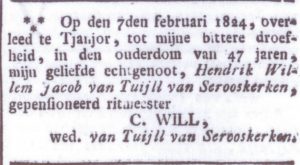 A representative post in February comes from Henry Hoff. Referring to his longtime subscription to De Nederlandsche Leeuw [The Dutch Lion], the journal of the Koninlijk Nederlandsch Genootschap voor Geslacht-en Wapenkunde [Royal Dutch Society for Genealogy and Heraldry], he notes:
A representative post in February comes from Henry Hoff. Referring to his longtime subscription to De Nederlandsche Leeuw [The Dutch Lion], the journal of the Koninlijk Nederlandsch Genootschap voor Geslacht-en Wapenkunde [Royal Dutch Society for Genealogy and Heraldry], he notes:
Sometimes [the journal includes] an article on a family that emigrated to the United States in the nineteenth century or had American connections. In the September 2017 issue (vol. 134, no. 3), at pages 143–60, is a fascinating and complex article, “Hendrik Willem Jacob van Tuyll van Serooskerken (1777–1824) en zijn tweede echgenote Catherine Halsey geb. Will (1780–1841).” The author, C. P. Briët, shows that Hendrik Willem Jacob van Tuyll van Serooskerken, a divorced Dutch baron, married in 1818 or 1819, perhaps in Philadelphia, Catherine (Will) Halsey, the American widow of an Englishman, Charles Herman Halsey, by whom she had three children. She and the baron had one child, Louise Henriette, born in 1819. The couple then moved to the Dutch East Indies, where the baron died in 1824.
A number of families likely descend from this couple, and Henry notes that they could well be "unaware of their fascinating ancestry and connections."
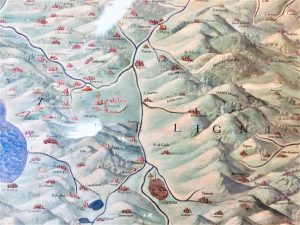 In March, former Research Services staff member Alessandro Ferzoco wrote about preparing for a visit to his Ferzoco ancestors’ native village, Corfinio (formerly Pentima), where a perplexing decline in population during the early eighteenth century drew his attention:
In March, former Research Services staff member Alessandro Ferzoco wrote about preparing for a visit to his Ferzoco ancestors’ native village, Corfinio (formerly Pentima), where a perplexing decline in population during the early eighteenth century drew his attention:
I conducted some general research on the region, and soon learned that Abruzzo had suffered two terrible earthquakes in 1703 and 1706. The 1706 earthquake seems to have hit Pentima and the surrounding towns more severely…
I requested that a colleague in Italy visit the ecclesiastical archive for me… He was able to locate an entry in the Libro Mortuorum for the town (the parish register for deaths).
In his initial count, the parish priest noted more than sixty deaths on 3 November 1706. The heading for the entry reads “Die 3 9bris in terremota perierunt infrascripti” – “On the 3rd day of November, the individuals listed below perished in the earthquake.” Among the dead was among them a distant great-uncle of mine, Michele Ferzoco, who died tragically at the age of six. Michele had survived the most difficult years of childhood – he had not died in infancy like so many others – only to be killed in the earthquake.
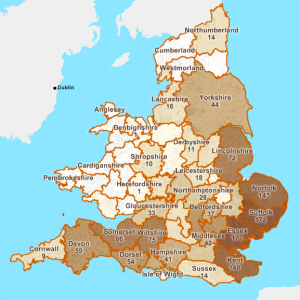 Reporting on a new initiative associated with the Great Migration Study Project (in April), Robert Charles Anderson described a talk he had given while crossing the Atlantic on the Queen Mary II:
Reporting on a new initiative associated with the Great Migration Study Project (in April), Robert Charles Anderson described a talk he had given while crossing the Atlantic on the Queen Mary II:
…I mentioned briefly that it had long been my dream to create an interactive online map to portray the migration process [during the period 1620–40]. At the end of that talk, Peter Van Demark – NEHGS member, regular tour participant, and, most importantly for this purpose, professional computer cartographer – came up to me and said that if I was serious about such a map, he would be glad to work with me. And so a four-year project was born.
To create the desired map, we needed three elements: two databases and a user interface to connect them. I created a crude version of what we called the origins database, by abstracting from The Great Migration Directory the last name, first name, year of migration, English origin, and first New England residence for each of the 1,800 entries for which the English origin was known. The second database we required was an electronic file of county and parish boundaries for England. The most useful one we could find was a map of these boundaries as of about 1851, for which we quickly obtained a license. With some assistance from me, Peter was able to massage many of the boundaries and place names so that they reflected the England of about 1630. Finally, Peter and his colleague Giovanni Flammia built an interface that would allow users to query the databases by name or by parish.
The resulting application is now available through AmericanAncestors.org.
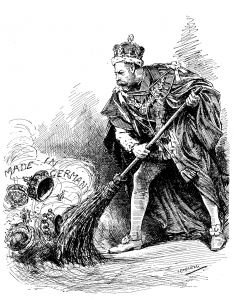 In May, Chris Child and I wrote about the ancestry of the newest member of the British royal family, Archie Harrison Mountbatten-Windsor, a fascinating mix of forebears:
In May, Chris Child and I wrote about the ancestry of the newest member of the British royal family, Archie Harrison Mountbatten-Windsor, a fascinating mix of forebears:
Archie’s great-grandmother, Queen Elizabeth II, is a Windsor, a member of the House of Windsor; his great-grandfather, the Duke of Edinburgh, is a Mountbatten via yet another name change: the Duke’s father was a Prince of Greece and Denmark, his mother a Princess of Battenberg…, and it suited everyone when, in 1947, Prince Philip of Greece and Denmark became Lieutenant Philip Mountbatten. After the Queen’s accession, it was determined that Windsor would remain the royal house name, but that Mountbatten-Windsor would be the family’s surname when needed.
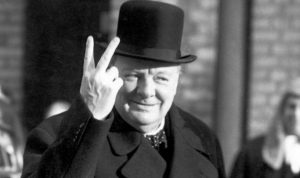 And, to wrap up the first half of the year, Chris reported on Mayor Pete Buttigieg’s interesting cousins, among them U.S. president Rutherford B. Hayes; actor John Wayne; and Diana, Princess of Wales.
And, to wrap up the first half of the year, Chris reported on Mayor Pete Buttigieg’s interesting cousins, among them U.S. president Rutherford B. Hayes; actor John Wayne; and Diana, Princess of Wales.
Most surprising, as … stated in the Averill genealogy, was that Solomon Murray’s brother Reuben Murray was the great-grandfather of Lady Randolph Churchill (born Jennie Jerome in Brooklyn, New York), mother of Sir Winston Churchill. This connection makes Mayor Pete and Winston Churchill fourth cousins four times removed.
Concluded here.
Share this:
About Scott C. Steward
Scott C. Steward has been NEHGS’ Editor-in-Chief since 2013. He is the author, co-author, or editor of genealogies of the Ayer, Le Roy, Lowell, Saltonstall, Thorndike, and Winthrop families. His articles have appeared in The New England Historical and Genealogical Register, NEXUS, New England Ancestors, American Ancestors, and The Pennsylvania Genealogical Magazine, and he has written book reviews for the Register, The New York Genealogical and Biographical Record, and the National Genealogical Society Quarterly.View all posts by Scott C. Steward →